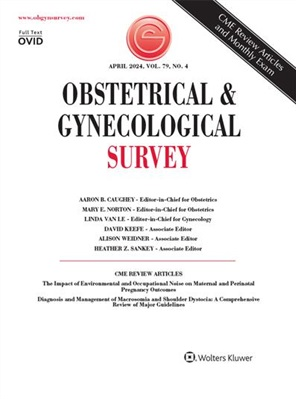Maternal Malignancy After Atypical Findings on Single-Nucleotide Polymorphism-Based Prenatal Cell-Free DNA Screening
IF 3.6
4区 医学
Q1 OBSTETRICS & GYNECOLOGY
引用次数: 0
Abstract
ABSTRACT Technological advances in prenatal testing are allowing for earlier screening to detect fetal aneuploidies, infection, or abnormalities. Noninvasive tests in particular have enabled clinicians to screen early in pregnancy for conditions that severely affect fetal and neonatal outcomes (trisomies 21, 18, and 13, among others). Some of these methods rely on cell-free DNA (cfDNA) circulating in the maternal blood stream; although cfDNA can be released by the placenta, malignancy can be another cause for the release of cfDNA. The detection of such malignancies on noninvasive prenatal tests is rare but occurs. This study was designed to assess the incidence of cfDNA results indicating maternal malignancy and compare these findings to the existing literature. This was a retrospective cohort study, including data obtained from a commercial laboratory that performed single-nucleotide polymorphism (SNP)–based noninvasive prenatal screening between January 2015 and October 2021. Screenings were considered suggestive of malignancy if retrospective bioinformatics and SNP plots suggested multiple maternal copy number variants for at least 2 chromosomes; the laboratory returned these tests as fetal uninterpretable results. Of 2,004,428 samples included in the analysis, 38 (0.002%, or 1 in 52,748) were considered suggestive of malignancy. For 30 patients where follow-up was completed, health outcomes were analyzed for mother and child with maternal malignancy observed in 20 of them (66.7%). Six individuals had a preexisting diagnosis of cancer, 2 of which had a personal history of cancer but were thought to be in remission. Malignancies included lymphoma (10 patients), breast cancer (5 patients), and colon cancer (3 patients). Fetal outcomes for 15 of these patients were normal, with a few abnormal outcomes in the others; negative outcomes included fetal abnormality, multiple soft markers on prenatal ultrasound, and fetal growth restriction. Of the 10 patients without reported malignancy, 2 had identified fetal triploidy, 1 had maternal glomerulonephritis, and 1 had uterine leiomyomas. Of the original 30 patients with results suggestive of malignancy, 6 had no issues reported on follow-up. The findings reported in this study are similar to previous findings of maternal malignancy detected by noninvasive prenatal screenings. The prevalence of maternal malignancy identified in this study was lower than in previous studies, which estimated the prevalence to range from 1/2000 to 1/21,000. The percentage of patients with a confirmed malignancy after suspicious results in this study was 67% and has ranged from 8% to 73% in other studies. Some patients who had an identified malignancy were diagnosed as long as 11 months after the noninvasive prenatal screening; this indicates that longitudinal follow-up may result in higher rates of identified malignancy among those who have screening results suggestive of malignancy. Clinically, these findings highlight the need for information given to expectant mothers about incidental findings pertaining to noninvasive prenatal screenings, as well as the importance of reporting suspicious results of these screenings. Further research should focus on determining rates of underreporting for maternal malignancy, as well as obtaining more complete follow-up data and potentially developing a standardized procedure or diagnostic workup to determine the true incidence.基于单核苷酸多态性的产前无细胞DNA筛查非典型发现后的母体恶性肿瘤
产前检测技术的进步使早期筛查检测胎儿非整倍体、感染或异常成为可能。特别是无创检查使临床医生能够在妊娠早期筛查严重影响胎儿和新生儿结局的疾病(21、18和13三体等)。其中一些方法依赖于母体血液循环中的无细胞DNA (cfDNA);虽然胎盘可以释放cfDNA,但恶性肿瘤可能是cfDNA释放的另一个原因。这种恶性肿瘤的检测在无创产前检查是罕见的,但发生。本研究旨在评估提示母体恶性肿瘤的cfDNA结果的发生率,并将这些结果与现有文献进行比较。这是一项回顾性队列研究,包括从商业实验室获得的数据,该实验室在2015年1月至2021年10月期间进行了基于单核苷酸多态性(SNP)的无创产前筛查。如果回顾性生物信息学和SNP图显示至少2条染色体存在多个母体拷贝数变异,则认为筛查提示恶性肿瘤;实验室返回了这些测试结果,结果是胎儿无法解释的。在纳入分析的2,004,428份样本中,38份(0.002%,即52,748份中的1份)被认为提示恶性肿瘤。对随访完成的30例患者进行母婴健康结局分析,其中20例(66.7%)观察到母体恶性肿瘤。6人之前被诊断患有癌症,其中2人有个人癌症病史,但被认为处于缓解期。恶性肿瘤包括淋巴瘤(10例)、乳腺癌(5例)和结肠癌(3例)。其中15例胎儿结局正常,其余部分胎儿结局异常;阴性结果包括胎儿异常、产前超声多发软标记物和胎儿生长受限。在未报告恶性肿瘤的10例患者中,2例发现胎儿三倍体,1例患有母体肾小球肾炎,1例患有子宫平滑肌瘤。在最初的30例结果提示恶性肿瘤的患者中,6例在随访中没有报告任何问题。本研究报告的发现与以前通过无创产前筛查检测到的母体恶性肿瘤的发现相似。本研究确定的孕产妇恶性肿瘤患病率低于以往的研究,此前的研究估计患病率在1/2000至1/21,000之间。在本研究中,可疑结果后确诊为恶性肿瘤的患者比例为67%,在其他研究中为8%至73%。一些确诊为恶性肿瘤的患者在无创产前筛查后长达11个月才被诊断出来;这表明纵向随访可能导致在那些有提示恶性肿瘤的筛查结果的患者中确定恶性肿瘤的比率更高。在临床上,这些发现强调了向准妈妈提供有关非侵入性产前筛查附带发现的信息的必要性,以及报告这些筛查可疑结果的重要性。进一步的研究应侧重于确定产妇恶性肿瘤的漏报率,以及获得更完整的随访数据,并可能制定标准化程序或诊断检查,以确定真正的发病率。
本文章由计算机程序翻译,如有差异,请以英文原文为准。
求助全文
约1分钟内获得全文
求助全文
来源期刊
CiteScore
2.70
自引率
3.20%
发文量
245
审稿时长
>12 weeks
期刊介绍:
Each monthly issue of Obstetrical & Gynecological Survey presents summaries of the most timely and clinically relevant research being published worldwide. These concise, easy-to-read summaries provide expert insight into how to apply the latest research to patient care. The accompanying editorial commentary puts the studies into perspective and supplies authoritative guidance. The result is a valuable, time-saving resource for busy clinicians.

 求助内容:
求助内容: 应助结果提醒方式:
应助结果提醒方式:


